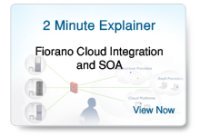Cloud-based Integration and SOA Architecture
Understanding the interaction between Cloud Computing and SOA
Executive Summary
Today's enterprise environment is rapidly changing. The disparate mix of operating systems, applications and databases for businesses and organizations is part of a rapidly evolving technological dynamic made even more complicated by the emergence of cloud computing. As Enterprise Software applications grow in complexity, the need for organizations to leverage cloud computing as part of their integration strategies is growing exponentially. Putting a cloud integration and Enterprise Service Bus (ESB) strategy in play prepares enterprises for the next generation of flexible, distributed and scalable cloud-enabled business applications while facilitating greater operational efficiency, generating more revenue, and helping businesses enter new markets.
The key to success in the networked economy is the ability to create and deploy distributed cloud-based ESB and SOA processes to integrate value chains in concert with changing requirements. Faster change management will help enterprises integrate their processes over the cloud so they can achieve greater efficiency, generate more revenue, and enter new markets.
This paper compares the following architectures for cloud-based integration, along with the pros and cons of each of the architectures:
- On-Premise to Cloud Integration
- Integration-as-a-Service (IaaS)
- Hybrid, Peer-to-Peer Cloud-based Architecture
The paper also discusses the architecture requirements for a general purpose, cloud-enabled ESB platform which enables the seamless integration of on-premise, public and private cloud applications.

 Japan
Japan Germany
Germany
